Rock urbano mexicano is a blues-based, working‑class strain of Mexican rock that foregrounds everyday "barrio" life, social critique, and street romance in colloquial Spanish. Musically it leans on gritty guitars, mid‑tempo grooves, pentatonic riffs, and rough‑edged vocals, often closer to garage and hard rock than to slick radio rock.
Born in the underground after Mexico’s early‑1970s crackdowns on rock, it established its own DIY circuit of venues, markets, and tape trading. The songs are direct, memorable, and chant‑friendly, with shuffles and straight 4/4 beats, power‑trio backlines, occasional harmonica, and choruses that audiences can shout together. Its ethos values authenticity over polish, turning urban struggle into communal catharsis.
After the 1971 Festival Rock y Ruedas de Avándaro, authorities curtailed public rock events, pushing the scene into clandestine "hoyos fonky" (makeshift venues). Blues‑rock outfits like Three Souls in My Mind (later El Tri) kept rock alive with Spanish lyrics and street‑level themes, laying the aesthetic foundations for what would become rock urbano.
In the early–mid 1980s, rock urbano crystallized as a distinct identity parallel to the mainstream "Rock en tu Idioma" wave. The Tianguis del Chopo (from 1980) became a crucial hub for cassette trading, fanzines, and gig networking. Songwriters from the Movimiento Rupestre (notably Rockdrigo González) injected urban storytelling and talk‑sing delivery into the DNA of the style. Bands like Banda Bostik, Tex Tex, Heavy Nopal, and Trolebús defined a raw, blues‑driven sound with gritty, colloquial lyrics.
The 1990s saw a proliferation of barrio‑rooted groups (El Haragán y Cía., Liran’ Roll, Interpuesto, Sam Sam, Charlie Monttana). Without major‑label polish, they built large audiences via massive "tocadas" on city peripheries, markets, and independent radio. The sound stayed faithful to bluesy riffs and anthemic choruses while addressing unemployment, addiction, love, and resilience.
Digital platforms broadened reach while the live ethos—call‑and‑response vocals, communal choruses—remained central. Newer acts continue the tradition of plain‑spoken storytelling and street‑level realism. The scene’s DIY infrastructure (Chopo, independent promoters, neighborhood festivals) sustains its intergenerational appeal and influences Mexican rock and hip hop narratives about urban life.


